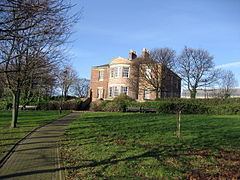OS grid reference NZ337654 | ||
 | ||
Similar Jarrow Hall – Anglo‑Sa, Jarrow Hall ‑ Anglo‑Sa, Monkwearmouth Station Museum, St Paul's Monastery - Jarrow, Monkwearmouth–Jarrow Abbey | ||
Jarrow hall welcomes home the codex amiatinus fascimile
Jarrow Hall is a grade II listed building in Jarrow, Tyne and Wear, North East, England, and part of the larger Jarrow Hall - Anglo-Saxon Farm, Village and Bede Museum site. It was built around 1785 by local businessman Simon Temple; he later went bankrupt in 1812 after a series of poor investments. The hall then passed through a number of hands before being let to the Shell Mex company in 1920, and then the Jarrow Council in 1935. The Council used the hall for a storage depot, eventually letting the building become derelict and in threat of demolition. It was rescued by the St Paul's Development Trust, which funded a £50,000 restoration project.
Contents
- Jarrow hall welcomes home the codex amiatinus fascimile
- An insight into bede and bede s world museum jarrow
- References
The hall then became the Bede Monastery Museum in 1974, as a means of exhibiting information about local scholar the Venerable Bede - the location of the hall next to St Paul's Church - part of the Monkwearmouth-Jarrow Abbey - meant it was an ideal location for the new museum. The Bede Monastery Museum became part of Bede's World which operated from 1993 to 2016, and is now part of Jarrow Hall - Anglo-Saxon Farm, Village and Bede Museum.
The hall is now used as the cafe for visitors to the museum and also houses the museum offices. A permanent exhibition entitled 'The Many Faces of Jarrow Hall' chronicles the lives of previous residents of the hall.
